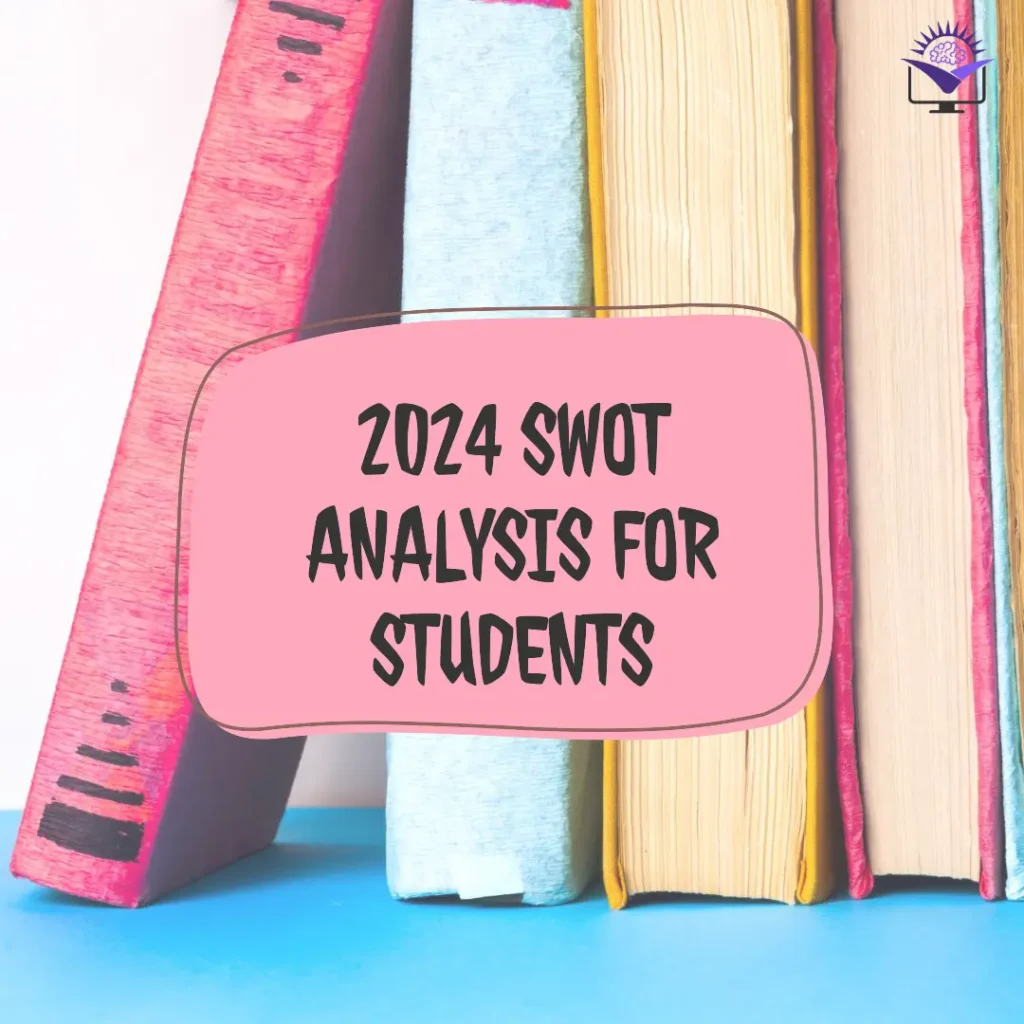A SWOT analysis is a powerful tool for personal and academic growth, especially for students. By understanding their Strengths, Weaknesses, Opportunities, and Threats, students can better navigate their educational journey and prepare for future challenges. In 2024, as the educational landscape continues to evolve, conducting a SWOT analysis has become more relevant than ever. This blog post will provide a comprehensive example of a SWOT analysis for a student, offering detailed insights and practical tips for maximizing the benefits of this strategic tool.
Comprehensive Example of a SWOT Analysis for a Student in 2024
Understanding SWOT Analysis
What is a SWOT Analysis?
A SWOT analysis is a structured planning method used to evaluate the Strengths, Weaknesses, Opportunities, and Threats involved in a project or in a personal or professional context. The primary goal is to identify internal and external factors that are favorable and unfavorable to achieving an objective. For students, a SWOT analysis can illuminate areas of academic and personal life that need improvement and highlight potential opportunities for growth and success.
History and Evolution of SWOT Analysis
The SWOT analysis framework originated in the 1960s and 1970s as a tool for business and strategic planning. It was developed by Albert Humphrey at the Stanford Research Institute. Over the years, it has evolved to become a versatile tool used in various fields, including education, personal development, and career planning. Its adaptability and simplicity have made it an invaluable resource for individuals and organizations worldwide.
Why SWOT Analysis is Relevant for Students in 2024
In 2024, the educational environment is increasingly competitive and dynamic. Students face numerous challenges, from adapting to new learning technologies to balancing academic and personal responsibilities. Conducting a SWOT analysis helps students gain a clear understanding of their strengths and weaknesses, enabling them to create effective strategies to leverage opportunities and mitigate threats. This proactive approach is essential for personal and academic success in today’s fast-paced world.
Steps to Conduct a SWOT Analysis for a Student
Identifying Strengths
Identifying strengths involves recognizing the positive attributes that set a student apart. These can be both academic and personal. For example, academic strengths might include proficiency in specific subjects, strong study habits, or high grades. Personal strengths could encompass skills such as time management, leadership, or effective communication. Recognizing these strengths allows students to build confidence and leverage these attributes to achieve their goals.
Recognizing Weaknesses
Acknowledging weaknesses is crucial for personal growth. Academic weaknesses might involve difficulties in particular subjects, poor time management, or a tendency to procrastinate. Personal weaknesses could include stress management issues, lack of experience, or difficulty in maintaining a work-life balance. By identifying these areas, students can develop strategies to address and overcome them, transforming weaknesses into opportunities for improvement.
Discovering Opportunities
Opportunities are external factors that a student can capitalize on to advance their academic and personal development. These might include scholarships, internships, networking events, or extracurricular activities that align with their interests and career goals. Identifying opportunities helps students to take proactive steps towards achieving their objectives and maximizing their potential.
Acknowledging Threats
Threats are external challenges that could hinder a student’s progress. These could range from academic pressures and competition to financial constraints and health concerns. Recognizing these threats is essential for developing contingency plans and strategies to mitigate their impact. By being aware of potential obstacles, students can better prepare themselves to handle adversity and maintain their focus on their goals.
Detailed Example of a SWOT Analysis for a Student in 2024
Example Student Profile
Let’s consider a hypothetical student named Sarah. She is a 20-year-old college sophomore majoring in Computer Science. Sarah is interested in software development and has been actively participating in coding boot camps and hackathons. She also balances part-time work with her studies.
Strengths of the Student
Sarah’s strengths include her proficiency in programming languages such as Python and Java, strong problem-solving skills, and excellent time management. Her participation in hackathons demonstrates her ability to work under pressure and collaborate with others. Additionally, her part-time job has helped her develop professional skills and financial independence.
Weaknesses of the Student
Sarah’s weaknesses include difficulty in managing stress during exam periods, a tendency to procrastinate on long-term projects, and limited experience in advanced topics like machine learning. She also struggles with balancing her social life and academic responsibilities, often feeling overwhelmed by her commitments.
Opportunities for the Student
Sarah has several opportunities available to her. She could apply for scholarships to reduce financial strain, seek internships at tech companies to gain practical experience, and join academic clubs to expand her network. Attending industry conferences and online courses could also enhance her knowledge and skills in emerging technologies.
Threats to the Student
The primary threats to Sarah include the highly competitive job market in the tech industry, the rapid pace of technological advancements requiring constant learning, and potential burnout from juggling multiple responsibilities. Additionally, economic uncertainties and potential health issues pose significant risks to her academic and personal well-being.
Benefits of Conducting a SWOT Analysis for Students
Personal Development
Conducting a SWOT analysis promotes self-awareness, helping students to understand their strengths and areas for improvement. This self-knowledge is crucial for personal development, enabling students to set realistic goals and develop effective strategies for growth. It fosters a proactive mindset, encouraging students to take control of their learning and personal journeys.
Academic Planning
A SWOT analysis aids in academic planning by highlighting areas where students excel and need support. By identifying strengths, students can focus on leveraging these to excel in their studies. Recognizing weaknesses allows for targeted efforts to improve in specific areas, while opportunities can guide decisions on extracurricular activities and career planning.
Career Preparation
For career preparation, a SWOT analysis is invaluable. It helps students to identify skills and experiences that are attractive to potential employers. By understanding the threats in their chosen field, students can take steps to mitigate these, such as gaining additional qualifications or experience. This strategic approach enhances their employability and readiness for the job market.
Tips for Students to Maximize Their SWOT Analysis
Regular Review and Updates
It’s important for students to regularly review and update their SWOT analysis. As they progress through their academic journey, their strengths, weaknesses, opportunities, and threats will evolve. Regular updates ensure that the analysis remains relevant and reflective of their current situation, allowing for continuous improvement and adaptation.
Seeking Feedback from Mentors and Peers
Seeking feedback from mentors, teachers, and peers can provide valuable external perspectives. Others may offer insights into strengths and weaknesses that students might not have considered. This feedback can help students to refine their analysis and develop more effective strategies for personal and academic growth.
Action Plan Development
A SWOT analysis is most effective when it leads to actionable steps. Students should develop a clear action plan based on their analysis, outlining specific goals and strategies for leveraging strengths, addressing weaknesses, seizing opportunities, and mitigating threats. This plan should be realistic, with measurable milestones to track progress.
Common Mistakes to Avoid in a Student SWOT Analysis
Overlooking Personal Weaknesses
One common mistake is overlooking personal weaknesses. It’s essential to be honest and critical during the analysis to identify areas that need improvement. Ignoring weaknesses can lead to complacency and hinder personal and academic growth.
Ignoring External Threats
Another mistake is ignoring external threats. Being aware of potential challenges allows students to prepare and develop strategies to overcome them. Ignoring these threats can result in being unprepared for difficulties that arise, impacting academic and personal success.
Failing to Utilize Opportunities
Failing to utilize opportunities is also a significant oversight. Students should actively seek and take advantage of opportunities that align with their goals. This proactive approach can open doors to new experiences, skills, and networks that are crucial for personal and academic development.
Tools and Resources for Conducting a SWOT Analysis
SWOT Analysis Templates
There are numerous SWOT analysis templates available online, both free and paid. These templates provide a structured format for conducting the analysis, making it easier for students to organize their thoughts and insights. Templates can be customized to fit individual needs and preferences.
Online Tools and Apps
Several online tools and apps are designed to facilitate SWOT analysis. These digital tools often include features such as interactive charts, collaborative platforms for group analysis, and integration with other planning tools. Utilizing these tools can streamline the process and enhance the effectiveness of the analysis.
Books and Courses
Books and online courses on strategic planning and personal development often include sections on SWOT analysis. These resources provide in-depth knowledge and practical tips for conducting an effective analysis. Recommended reading and courses can help students to deepen their understanding and improve their analytical skills.
Real-Life Examples and Case Studies
Student Success Stories
Numerous students have successfully used SWOT analysis to achieve their academic and personal goals. For instance, a student who struggled with time management might have identified this weakness through a SWOT analysis and implemented strategies to improve. Over time, this led to better academic performance and reduced stress.
Case Studies of SWOT Analysis in Education
Educational institutions often use SWOT analysis to assess programs and initiatives. Case studies from universities and schools provide valuable insights into how SWOT analysis can be applied in an academic context. These examples demonstrate the practical benefits and outcomes of using this tool for strategic planning and improvement.
Conclusion
In conclusion, conducting a SWOT analysis is a powerful tool for students to navigate their academic and personal journeys. By understanding their strengths, weaknesses, opportunities, and threats, students can develop effective strategies for growth and success. Regular updates, seeking feedback, and developing actionable plans are key to maximizing the benefits of a SWOT analysis. As the educational landscape continues to evolve in 2024, this proactive approach is essential for students to achieve their goals and thrive in a competitive environment.



